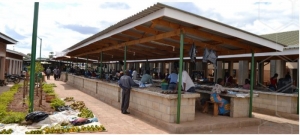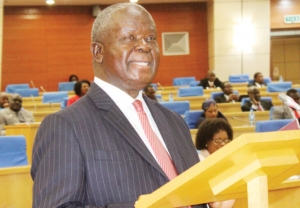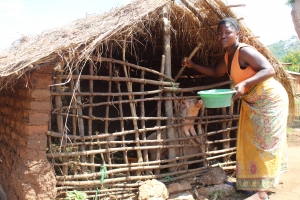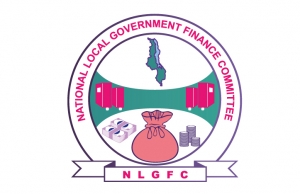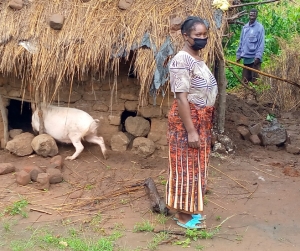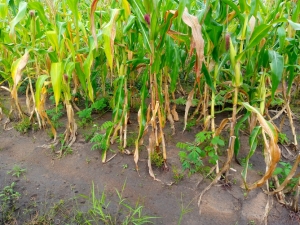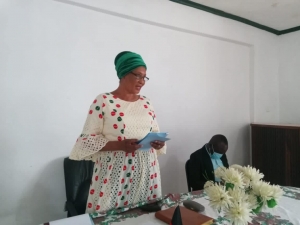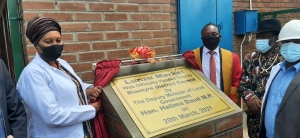
Symon Lubanga
Vendors excited with the New Lunzu Market
Its now three months since government through the Ministry of Local Government handed over new constructed Lunzu Market to the community and a visit to the market recently revealed that Vendors have occupied all the spaces and are happy with the new premises.
Many people feared that the market will be another White elephant as it has been a traditional for vendors not relocating to new markets in most areas. However, the story is different with Lunzu Market, as vendors are happy operating inside the market.
Violet Joya, a vegetable seller, says her business is booming because she has a shelter where they operate irrespective of the weather.
"Previously, when we were operating outside the market it was difficult when it was cold, raining or dusty as we were forced to run away since we had no shelter. Now l can proudly say we don't quiver even if it starts raining or anything because as you can see we are in a well protected shelter,” She says.
For Wesley Maloni, ever since they started operating inside the market, they are receiving many customers because all their merchandise is placed at one selling point.
" When we were outside it was difficult for our customers to find us since we were scattered, while nowadays we are all at one selling point and this gives our customers to buy what they want within walking distance of one bench with another," he said.
Mervis Namakalo, who sells fish said the environment inside the market is good as there is very little dust or mud during rain season. " previously, outside the market we had difficulties due to dust that used to spoil our fish but since we started inside we no longer complain of dust and mud," She said.
Chairman of the market, Henderson Ligomeka said vendors are satisfied operating inside the market and says only a few who have failed to secure places inside are the ones still outside.
" As you can see inside the market there is no longer space as every vendor wants to operate inside. This is what we have been waiting for. Vendors are very happy because of the shades plus toilets and bathrooms. When they are tired they go and have a shower,” he said.
One customer, Josephine Kanga said they like the design inside the market because now it is easy to locate where what they want is without wasitng unnecessary time looking for what you want. " Way back if you want to buy vegetables it was difficult to locate these people but now you go to one place and boom, tht is where they are and much more”, she said.
The More Income and Empowerment in Rural Areas (MIERA) Project under which the new market has been constructed, is also supporting similar market constructions at Sadzi in Zomba, Neno market, Goliati in Thyolo, Dyeratu in Chikwawa, Nkhata Bay and Chinkhoma in Kasungu. The project is run through the facilitation of National Local Government Finance Committee (NLGFC) with support from the Germany Government through KFW Bank.
Third Phase CUCI Payments Rolled Out
Malawi Government has commenced disbursements of the third phase payments to the beneficiaries of the Emergency Cash Transfer under the Covid-19 Urban Cash Intervention (CUCI).
The actual payments to CUCI beneficiaries commenced in February 2021 with monthly cash injections of MK35, 000 for three months (January –March 2021).
However, only those that successfully identified themselves in the Know-Your Customer (KYC) received the transfers. “74,150 beneficiaries will be paid during this phase. These beneficiaries were not paid in the past two phases due to the challenges faced with KYC processes and other technical problems.
A further 42,000 beneficiaries who were not paid during the first phase (payment of January and February) will also get their cash in this third phase” said Bessie Msusa, Chief Economist at the department of Economic Plannning and Development.
CUCI is a government intervention being implemented in low-income semi-urban locations based on the assessment of the cities- socio-economic profiles and household vulnerability levels.
The qualifying beneficiaries are the ultra-poor households who primarily derive their livelihoods from the informal employment and micro trading.
Out of the targeted 199, 613 beneficiary households, the programme has reached to 137,772 beneficiaries in the cities on Blantyre, Zomba. Lilongwe and Mzuzu. The cash transfers are done electronically through mobile money service providers-Airtel Money Commerce Ltd and TNM Mpamba Ltd.
The programme is supported by the Government of Malawi and its cooperating partners including UNICEF, the German Government through the KFW and GIZ, International Labour Organisation, World Food Programme, the Embassy of Ireland, the European Union and the World Bank.
Mk289.2 Bn, Govt Grants To Local Councils In 2021/22 Fiscal Year
THE 2021/22 Local Authorities’ budget is estimated at MK 282.52 billion. The reflect a 6% decrease when compared to the approved budget of 2020/21 financial year mainly due to the revised government financial year from 12 months in 2020-2021 (July – June) to a transition of 9months (July – March for the April – March thereafter).
In the budget statement presented by Minister of finance Felix Mlusu in the National Assembly, Personal Emoluments (PE) comprise a major part of the budget estimated at MK214.96 billion (76% of budget).
The budget for Other Recurrent Transactions (ORT) is estimated at MK 37.54 billion (13% of budget) and includes the Constituency Development Fund (CDF) estimated at MK 7.72 billion, the General Resource Fund estimated at MK 2.53 billion (1%) and the budget for all devolved sectors estimated at MK 27.29 billion (10%).
The Development Budget is estimated at MK 30.08 billion and comprises of resources for Construction of City roads estimated at MK 23.30 billion, the Borehole and Water Structures fund estimated at MK 2.32 billion, the District Development Fund (DDF) estimated at MK 2.80 billion, Dualization of Chileka –Blantyre Road estimated at MK1.0 billion and the Infrastructure Development Fund estimated at MK 0.61 billion.
In his statement, Mlusu further said on CDF each constituency is allocated MK40 million per year.
According to NLGFC Budget Analyst Jonathan Banda, CDF is used for implementing small projects and other emergencies that occur within the constituencies including rehabilitation of existing infrastructures.
On his part, the Executive Director of National Local Government Finance Committee (NLGFC), Alifeyo Banda appeals for 'more support from all stakeholders to the Fiscal Decentralisation process so that coordinated and effective guidance is provided to Local Authorities to enhance accountability and improved service delivery to the communities in the budget implementation process'
Composition of the Central Government Transfers
A LIFE CHANGING K21,000
Pita Banda, a mother of two in group village head Mbeza in Dowa, does not really remember the last time she had K21, 000 cash at once. She can make money from piecework and get as much as K5000 that is immediately spent on household needs without a significant saving.
While they have a sizeable land for crop production, she confesses that they are into subsistence farming and nothing “serious for sale”. When the weather is bad or say during drought – they really starve. For Banda, only if she got an opportunity for more money, she would invest it into something else to make her home food secure.
“When I got selected to participate in the works program from which I could be earning K21, 600 in a month, I felt like I was dreaming. It was too good to be true” she narrated during an interview at her place whose surrounding speaks for itself how it has been improved.
A few meters away from the house there is a heap of harvested maize, which she calculates to be worth 15 bags of 50 kilograms each and can take them through to the next season as a family of four. Besides the maize the chicken, of different sizes, are seen loitering as if to prove her right that she indeed owns them. At a distance, pigs are seen feasting on the feed she had just provided them.
“If you came last year at a time like this one, you would have nothing to see here. I have bought the chickens and pigs through the money I got from the works program. I never had a chance to make such money in my life. For three phases I got K64, 800” she explained with a sense of pride.
Banda is among those enrolled in the government funded Enhanced Public Works Programme (EPWP) which is being implemented in 10 district councils including her Dowa district. It is an eight month pilot program which targets ultra-poor households who are engaged in public work.
Banda is among 200 beneficiaries in Tovi catchment area in Dowa who are undertaking a re-afforestation initiative in a 250-hectares of land. So, far they have planted about 40,000 trees and making every effort to conserve these trees in the interest of the community itself.
“The community work for 24 days. The first five days is community contribution and the rest of the days they are paid K21, 600. They have so far received this money for three cycles” explained Julius Thaulo an agriculture extension worker in the area.
Banda’s story mirrors other beneficiaries. Each one of them has a success story to share. It looks like some health competition amongst themselves. Some will talk of how they have managed to improve their housing, others have been able to pay school fees for their wards and indeed some have bought themselves assets such as bicycles for personal use and business.
Hanki Manjulenje from group village headman Kasalika in the same district is another beneficiary whose biggest achievement is her ability to buy new blanket – she always wanted to have.
Recounting her benefits, she said from her first pay she bought the subsidized fertiliser and a bag of maize for food and from the second payment she bought a goat at K18,000.
That is not all she said: “I longed for a South African blanket which comes with a carrier bag. Once I got the third payment I really needed to buy this and indeed I bought it. I felt embarrassed for lack of better beddings, I now have something worth showing off”.
The pilot EPWP, under the National Local Government Finance Committee (NLGFC), was rolled out in September, 2020 run for eight months. Other beneficiary districts are are Chitipa, Karonga, Nkhotakota, Kasungu, Lilongwe, Balaka, Chiradzulu, Phalombe and Blantrye.
Dissecting sources of revenue for local authorities
For councils to operate as distinct local government entities, they need to have resources. In this discourse, I set out to describe the three main sources of revenue for councils in order to bridge the information gap that exist among different stakeholders regarding revenue sources of the council which in itself brings about a mismatch in expectations from such stakeholders and what councils actually deliver to the citizenry.
To begin with, Councils’ existence as local government areas came in the wake of implementation of National Decentralization Policy by Malawi Government since 1998. The policy defined the local government areas (35) which comprised districts, towns, municipals and cities with the view of improving service delivery to the communities. These local government areas have been the main implementing agents of Malawi Government Policies. These councils have been empowered through the Decentralization Policy and Local Government Act to implement the functions which have since been devolved from line ministries to the local government level. The Local Government Act second schedule defines the sources of revenue for councils to include: central government transfers, locally generated revenue and funds from Development partners as well Non-governmental organizations.
Central government transfers to councils include all those resources which are sent to councils in order for the council to implement sectoral policies at local level as well as operational resources which are given to councils to facilitate implementation for the same. The number of sectors that have devolved over time has grown from three in 2005/6 financial year to currently sixteen. Among these include: education, health, agriculture, water, gender, immigration, irrigation, trade, housing, National Registration Bureau (NRB) youth and sports. These are otherwise known as devolved funds. Central government transfers also include the funds which are meant for implementation of development projects in councils such as District Development fund (DDF), Infrastructure Development Fund (IDF), Constituency Development Fund (CDF) as well as Boreholes Fund. Urban councils are limited to IDF and specifically for cities they also access city roads rehabilitation resources (through Roads Fund Administration) as well. A typical district council gets District Development Fund, Constituency Development Fund and Boreholes Funds which vary across council depending on some selected parameters. There is no Constituency Development Fund that is allocated to municipals and town councils because the CDF are already conveniently attached to the district except for cities which are relatively bigger.
The second source of revenue for councils is locally generated revenue. Councils are empowered by the local government act 1998/2010 through to collect local revenue in their respective areas of jurisdiction. Five main sources of revenue include: Income from market establishments, income from commercial ventures, fees and service charges, licenses and permits and property rates. Only urban councils can collect from all these sources, but a typical district council does not collect property rates. These resources are used by the councils at that level without sending these resources to the famous Malawi Government Account NUMBER ONE. The LGA also defined, long term revenue sources that are expected to be ceded to councils as follows: Toll gates, casino and gambling fees, motor vehicle registration fees, fuel levy and industrial registration. These have up to now not been ceded to councils for different reasons.
Finally, the councils also get resources for implementing various projects through development partners as well as Non-governmental organization. These resources may be sent directly to councils or the relevant partners may donate in kind or in whichever way as agreed by the two parties. They may set the accountability systems as deemed convenient and consistent with Public Finance Management Act and related statues.
The current status for these revenue sources is around K73 billion using the 2020/21 budget estimates. Central government transfers were estimated around K53 billion, locally generated revenue was estimated to contribute K20 billion. In terms of projects coordinated directly by NLGFC (Social Cash Transfer, Enhanced Public Work Programme (EPWP) K893 million and K12 billion under Social Support for Resilient Livelihood Programme coming to a total of K13 billion was estimated to be disbursed to councils in the 2020/21 financial year. There is no concrete data for Development partners and Non-governmental organizations working in all the councils as they do not fund the councils through NLGFC.
A NLGFC our huge role has been to ensure that these public resources are used to improve the standards of the citizenry. Specifically, allocating central government transfer, monitoring the utilization of resources in accordance with Public Finance Management Act, ensuring that councils are optimizing their local revenue collection potential and ensuring financial accountability systems are in place. Due to the convenience of our institution and expertise, NLGFC is also coordinating implementation of various world Bank funded programmes such as Social Cash Transfer, Enhanced Public Works Programme, SSRLP and the recently launched Governance to Enable Service Delivery (GESD). The LGA also defined, long term revenue sources that are expected to be ceded to councils as follows: Toll gates, casino and gambling fees, motor vehicle registration fees, fuel levy and industrial registration. These have up to now not been ceded to councils for different reasons.
EPWP producing assets for both communities and households in Kasungu
The pilot Enhanced Public Works Programme (EPWP) is helping people from Traditional Authority (TA) Mwase create assets for both the community and individuals.
The interventions under the programme include afforestation and land resource management where the communities have planted trees that they hope to turn into community forests apart from conserving soil which will help in more crop yields.
Foreman supervising the public works activities in the catchment area Patroba Chinyanga said the area is set to have a community forest with the trees that have been planted in bare areas.
We have planted about 15 thousand trees that have all done well. We have different varieties like Nkunkhu, Ntangatanga, Nthethe and Nsangu and in the end we are hopeful that the community will have a big forest, said Chinyanga.
Through working in the sub projects of the EPWP beneficiaries are paid some money which some have also tried to gather assets for their households.
Patricia Zimba, of Feza village who together with her husband look after 12 children and survive on small scale business, decided to buy a pig which she hopes will multiply.
I decided to buy a pig from the money I earned after working in the public works programme. I am hopeful the pig will help me make money after it gives birth, said Zimba.
The assets created gives hope to community to produce tangible resources for future use according to Kasungu EPWP liaison officer Kingster Kathumba.
The implementation of EPWP sub projects in all catchments gives hope of creating more quality assets within a short period of time, said Kathumba.
Kasungu has five catchments under EPWP in Chankhanga, Mphazi, Katcherekhwanya, Chatalala and Mpherere.
National Local Government Finance Committee (NLGFC) is implementing the pilot climate smart EPWP in Kasungu, Lilongwe, Dowa, Nkhotakota, Karonga, Chitipa, Chiradzulu, Blantyre, Balaka and Phalombe.
EPWP contributes to good crop yield in Mphazi catchment as PCI hails the community
The crops outlook in Kasungu looks good in most fields promising a good yield for most households.
The prospects of having a good yield has been attributed to the good rains and also the Affordable Input Programme (AIP).
Much as this is the case, the pilot climate smart Enhanced Public Works Programme (EPWP) has also contributed to the good yield.
Chairperson of Mphazi Catchment Area Khamalatha Siliya said most of the farmers who are beneficiaries of EPWP had money to buy fertilizer for their maize fields and now the maize fields look promising.
“The good thing was that the people here received the project with both hands when it came. They were committed to work in the sub projects and in the end got their pay,
“It is with this payment that most beneficiaries had to buy bags of the subsidized fertilizer for their maize fields and the rest of the money used for other needs,” said Siliya.
The hope of yielding more crops through earnings from EPWP is just a bonus to what the beneficiaries have done at Mphazi catchment.
About 18,970 trees have been planted on top of 840 bamboos which most have done well.
The catchment also has other sub projects in soil conservation where they have planted vetiver grass to control soil from being washed away and in agroforestry where fertilizer trees like Gliricidia sepium have been planted in fields.
PCI Malawi, one of the organizations working with communities in combating food insecurity and drought, and its partner Emmanuel International had to visit and appreciate what the communities are doing in Mphazi catchment.
Jam Masebo disaster and risk reduction coordinator for Emmanuel International said he was satisfied and enlightened with the visit.
Masebo said if the community in the catchment can take care of the assets they are creating there will be change.
“It is important for everyone in the committee to know what is happening in the programme and be able to know what needs to be achieved,
He however said councils should also take a huge role in driving the initiative.
“Let these be part of the District Development Plans (DDP) and let councils take a role in monitoring and supervising,” he said.
Team leader for PCI Jones Chimpukuso however urged the catchment committees to always put down in writing whatever they are doing as a committee.
“Documentation of your activities is not there despite the committee meeting most of the times. There is need to have somewhere where things are written down,” said Chimpukuso.
Story Credit: Vincent Khonje, District Information Officer, Kasungu
National Local Government Finance Committee (NLGFC) is implementing the pilot EPWP in Kasungu, Lilongwe, Dowa, Nkhotakota, Karonga, Chitipa, Chiradzulu, Blantyre, Balaka and Phalombe.
GESD PROJECT SENSITISATION TO LAs
Government hands over K614 million Lunzu Market
Government has officially handed over the magnificent Lunzu Market in Blantyre worth K6144 Million under More Income and Employment in Rural Areas (MIERA) project.
Speaking during the official ceremony on Saturday in Blantyre, deputy minister of Local Government Halima Daud described the German KFW Bank funded market as an essential catalyst in providing socioeconomic environment to boost livelihoods among people living in the rural areas who are the majority of the country’s population.
Said Daud; “This newly constructed modern market will provide farmers, businesses and entrepreneurs with a place and facilities where they can sell their produce and public with a conducive structure to access various products and services and in so doing, Improve their economic status”.
Daud then appealed to Blantyre District Council to come up with ways to make the market exceptional in revenue collection service provision, citizen satisfaction, care and maintenance to ensure a long-lasting structure.
Speaking earlier, Blantyre District Council Chairperson Mussa Chikwakwa said the market has uplifted the face of the district and promised the council will now start raising funds to construct an equally modern bus terminal behind the market.
While appealing to traders to effectively utilize the market, the chairperson also urged the newly elected market leadership to guard facility saying “it is such structures that promote the growth of any economy”.
KFW country director Oliver Gleiss said Lunzu Market was one of the eight markets that had been financed by the bank to a tune of €7 million (K7 billion) with facilitation of the National Local Government Finance Committee (NLGFC).
Other market constructions that have benefited from the project are Sadzi, Goliati, Neno, Nkhatabay, Dyeratu, Chinkhoma and Embangweni.
The MIERA project started in January, 2017 and expected to end December,2020. However, the project was extended by a year due to delayed technical issues.
Story Credits: Loness Gwazanga, District Information Officer, Blantyre
NLGFC Board of Directors
Left to right: Noel Kabambe, Councillor Wild Ndipo, Commissioner Steve Duwa, James Ali, Abel Mwambinga


